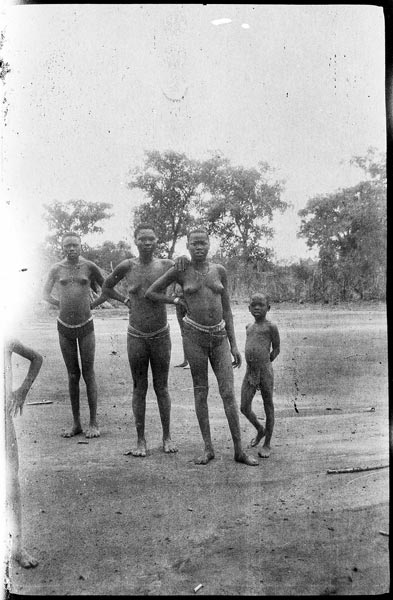Pitt Rivers Museum Luo Visual History

1998.349.250.1 (Film Negative 120mm)
Key Information
Photographer
Edward Evan Evans-Pritchard
Description
This photograph shows well the basic way of dressing by Luo women and girls before both European and coastal Kenyan influences became dominant in Nyanza. The upper body is bare except for neck beads (tik ng'ut). The beads were made from materials such as animal teeth, bone, and plant seeds, with glass beads only coming later. The woman to the right nearest the child has a necklace seemingly made of teeth strung on a cord. The necklaces worn by the women to the left are difficult to distinguish. They also wear wrist rings or bangles (minyonge) but the material is difficult to make out. Judging by their appearance these are unmarried women, a fact which is also attested to by the items worn around their waists. The girls on the left and right wear a waist apron (chip) of hide reinforced by small wood sticks and decorated with beads. The middle one wears waist beads (tik nungo) possibly of glass. The child simply has a lap cover of probably cloth (omethe) from a string belt tied around the waist. [Gilbert Oteyo 9/9/2004]
Cultural Group
?Luo
Region
?Nyanza
Pitt Rivers Source
Edward Evan Evans-Pritchard
Research Notes
Although the description I have given seems to fit Luo custom, there are aspects of this photo that do not fit with other images taken by Evans-Pritchard in Luo Country. The most important point is that the format of the photograph is different to the other Rolleiflex ones. Could this be taken in Southern Sudan, as I suggest also in 1998.349.255 and 1998.349.334? [Gilbert Oteyo 9/9/2004]
Date of Photograph
1936
Accession number
1998.349.250.1
Further Information
Photographic Process
Negative film nitrate
Date Acquired
Donated 1988
For citation use:
Pitt Rivers Museum Luo Visual History
"1998.349.250.1"
6 Jun. 2008. Pitt Rivers Museum.
Accessed 19 Nov. 2015
<http://photos.prm.ox.ac.uk/luo/photo/1998.349.250.1/>.
© Pitt Rivers Museum